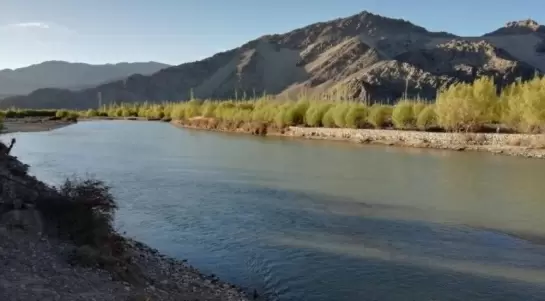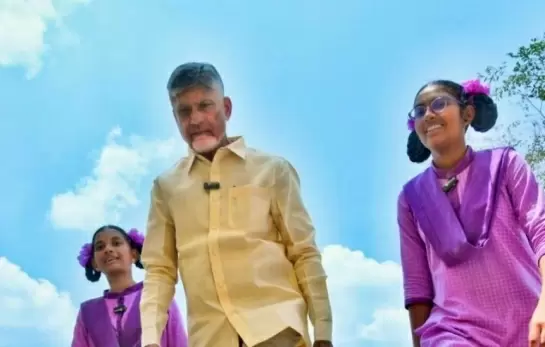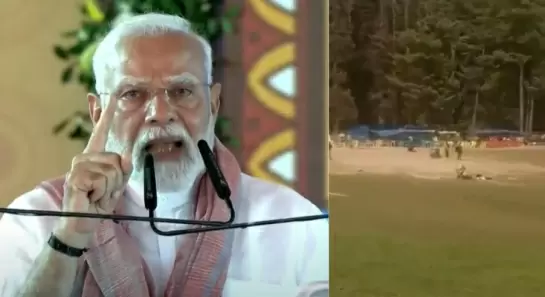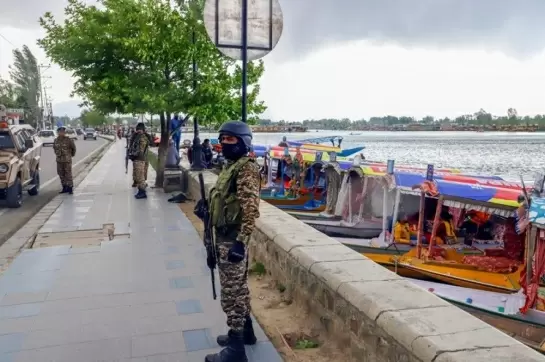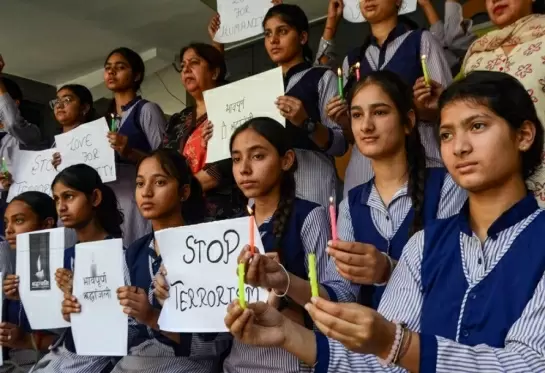Rajapaksa wanted peace, but India wanted war
26-May-2014
Although the controversial invitation to SAARC heads of governments for the 26 May swearing-in of Narendra Modi as Prime Minister was intended for President Mahinda Rajapaksa of Sri Lanka, he had invited CV Wigneswaran, Chief Minister of the Northern Province, to accompany him to New Delhi in the hope he can convey to the people of India that all is well between Colombo and Jaffna.
Wigneswaran declined to accompany the President to New Delhi. This May marks the 5th anniversary of the mass killing of Tamils by the Sri Lankan armed forces in the closing days of the civil war in 2009.
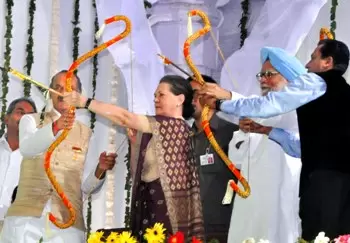 |
|
Rajapaksa has stated “we fought India’s war." (Photo: Indian Photo Agency)
|
These killings prompted UN Secretary-General Ban Ki-Moon to appoint a panel of experts to report on the scale of killings. The panel’s report said “tens of thousands of Tamil civilians were killed” due to deliberate and intense shelling and bombing of areas designated by the government as “no-fire-zones” where they had assembled for safety.
The report said the killings and other abuses that took place amount to war crimes and crimes against humanity. There are aspects of these abuses that constitute an act of genocide.
On the day external affairs ministry sent out the invitation to Rajapaksa, in Washington DC, the US Congress, by Resolution 587, recommended that the Department of State place restrictions on entry to the USA for anyone it identifies as responsible for war crimes and crimes against humanity.
The 22 May Resolution called on the government to prioritise the demilitarisation process throughout Sri Lanka and remove military from civil administration, allow for greater media freedom, protection of Press, and ensure religious freedom.
The last phase of the civil war in Sri Lanka and atrocities committed therein, described as “war without witness” because of total censorship of news, passed off mostly unreported. Fresh evidence of what happened in the last two days of the war, pieced together from telephone conversations between the persons involved, have just surfaced.
Having pushed the LTTE to a narrow strip of land at Mullivaikal, Basil Rajapaksa, formerly adviser to his brother, President Rajapaksa, and presently minister of economic development, negotiated for the surrender of the rebel leaders, closely monitored by Palitha Kohona, then foreign secretary who is now Sri Lanka’s permanent representative to the UN.
On the morning of Sunday, 17 May, 2009, Kohana sends an SMS to Nadesan, head of LTTE’s political wing, via a European intermediary, “Just walk across to the troops slowly and comply with instructions carefully. The soldiers are nervous about suicide bombers. White flag, hands up, walk slowly.”
Nadesan calls a TNA MP, Chandra Nehru, in Colombo, at 01.30 on Monday, 18 May, and says the Army is very close. In the background can be heard shelling, small arms fire and screaming. He confirms there are 3,000 LTTE and 22,000 civilians who want to surrender, and asks, “Why are they shelling if the government has agreed to the terms of surrender?” Nehru assures him the government has indeed agreed.
Marie Colvin, a journalist in London following the events closely, wakes up Vijay Nambiar, Chief of Staff of the UN Secretary General deputed to Colombo to oversee the surrender, in the early hours of Monday pleading with him to be at the venue of the surrender.
He assures her that President Rajapaksa himself had assured him that the surrendering LTTE and civilians would be safe and therefore there was no need for him to be present. His brother, Lt-Gen Satish Nambiar of the Indian Army, was the ‘war adviser’ to President Rajapaksa. Nehru calls Rajapaksa as reports of shelling continued.
The President says he has consulted Gotabaya Rajapaksa, defence secretary, and assures Nehru that all plans are in place for safe surrender of the willing. Nehru offers to go and oversee the surrender. The President says, “No. Our army is very generous and disciplined. There is no need for you to go to the war zone and put yourself at risk.”
At 06.20, Basil Rajapaksa tells Nadesan everything will be all right. “Wave a white flag and hold it very high,” and gives instructions on the route to take and says the 3,000 LTTE are to come separately from the civilians.
At 06.45, Kohana was informed that Nadesan was on his way to surrender. He replies by SMS, “This is very good news. Now let us rebuild the country and the shattered lives of all our people.”
Two hours later came the news that all the surrendered were shot dead by commandos. Nadesan’s wife, a Sinhalese, begged the commandos to stop shooting. She too was shot dead.
Soon after the carnage, President Rajapaksa said “we fought India’s war.” Gotabaya Rajapaksa explained how. “The President went out of his way to keep New Delhi briefed on developments at all times. In addition, a special bilateral committee was set up at the highest level, including then senior presidential adviser Basil Rajapaksa, secretary to the President Lalit Weeratunga, and myself as defence secretary from the Sri Lanka side.
“The Indian side comprised of former National Security Adviser MK Narayanan, then foreign secretary Shiv Shankar Menon and the defence secretary of the time, Vijay Singh. This troika had continuous discussions and ensured that any sensitive issue was dealt with as soon as it arose.”
Rajapaksa was right in claiming he fought India’s war in Sri Lanka because a powerful Indian politician wanted the top leadership of the LTTE decapitated in the belief dead men tell no tales. If tens of thousands of innocent civilians had to be killed in the process, it did not matter.
The government of Manmohan Singh and the entire PMO blindly carried out the wish of the politician by making available to Colombo the necessary military hardware, personnel and technology. Dead men do tell tales. If a proper investigation into one of the most dastardly crimes committed on the Indian soil is ordered, truth will be out.
Not many in India know that Rajapaksa began his public life as a human rights activist and became President of Sri Lanka with the indirect support of the LTTE. On assuming office, he wanted to go down in history as “Peace President” who had resolved the intractable ethnic crisis without resorting to war.
His feelers to New Delhi were rebuffed by the UPA government. Then he turned his attention to civil society in Tamil Nadu to help him resolve the ethnic crisis. A group of concerned citizens from Tamil Nadu had its first meeting with President Rajapaksa and his team comprising Lalith Weeratunga, secretary to the President, assistant secretary Waruna Sri Dhanapala and adviser Fernando in Colombo on 17 July 2007.
Throughout the two-hour discussions, Rajapaksa gave the impression that he was not unduly worried about international criticism of his regime but was greatly concerned about Indian opinion. He fully endorsed the group’s opinion that the solution to the crisis should emerge from within Sri Lanka and refined through international opinion, particularly from India.
After the two-day meetings with the Tamil Nadu group, Rajapaksa said at a public function “we ought to be sensitive and responsive to the genuine grievances of the people in the North-East,” traditional homeland of the Sri Lankan Tamils.
Since then, the Tamil Nadu group had a series of meetings with Rajapaksa’s team of officials and ministers in Colombo and Chennai to carry forward the effort and agreed upon many steps to resolve the conflict.
Another crucial conference was held with President Rajapaksa in Colombo on 25 March 2008, followed by a series of meetings with DEW Gunasekara, Sri Lankan Minister for Constitutional Affairs and National Integration, Raja Collure, chairman of official language commission, and others for evolving a political solution and confidence-building measures and an action programme was drawn up.
New Delhi was alerted by the Indian High Commission in Colombo about the progress made by back channel negotiations. The PMO moved quickly with military aid to Sri Lanka and wanted the LTTE liquidated.
The explanation given for this U-turn in foreign policy was that unless India aided Sri Lanka militarily, Pakistan and China would enter the arena and establish their hegemony in the island nation. Today, Islamabad and Beijing are far closer to Colombo than New Delhi.
The Narendra Modi government should consider nominating an independent person acquainted with the problems the Tamils in the island nation are facing as Special Representative for Sri Lanka to go into all aspects of the ethnic crisis, including vexing issues like fishing in the Palk Straits, and come out with a comprehensive solution-oriented blue print and oversee its implementation. Otherwise, the problem will be back to square one.
Sam Rajappa is Consulting Editor of The Weekend Leader
Ex-Andhra Intelligence Chief PSR Anjaneyulu Arrested Over Actress Kadambari Jethwani Harassment Case
Pope Francis Requested For Simplified Funeral Rites
Elista Launches Six New Made-in-India Residential Air Conditioners
Former DGP Om Prakash Murder: Wife Under Investigation, Says Minister
Ricky Rai, Son of Underworld Don Muthappa Rai, Shot at Near Bengaluru




